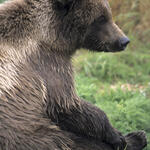The Arctic is a region like no other in the world and it’s warming twice as fast, bringing with it rapid change impacting life on land and at sea.
About 4 million people live in the Arctic, spread out over eight countries, including the United States. Diverse landscapes—from the sea ice to coastal wetlands, upland tundra, mountains, wide rivers, and the sea itself—support abundant wildlife and many cultures. Of all the wildlife in the Arctic, the polar bear is the most fitting icon for this region. It's amazing adaptation to life in the harsh Arctic environment makes it an impressive species.
Within America’s Arctic, the remarkably productive waters of the Bering Sea attract marine mammals, such as gray whales, which travel great distances to forage and raise their young. Almost half of the fish caught in the United States comes from here making fisheries vital to local livelihoods. Across the Bering Sea in Russia, the Kamchatka Peninsula’s river systems produce up to one-quarter of all wild Pacific salmon. The salmon provide nourishment to other wildlife, including the Kamchatka brown bear.
The Arctic, including the Bering, Beaufort and Chukchi seas, now faces an uncertain future due to climate change, mining, shipping, oil and gas development, and overfishing.
 Polar Bear
Polar Bear
 Gray Whale
Gray Whale
 Bowhead Whale
Bowhead Whale
 Fin Whale
Fin Whale
 Sei Whale
Sei Whale
 Whale
Whale
 Arctic Wolf
Arctic Wolf
 Pacific Salmon
Pacific Salmon
 Seals
Seals
 Dolphins and Porpoises
Dolphins and Porpoises
 Brown Bear
Brown Bear
 Narwhal
Narwhal
 Beluga
Beluga









 Elisabeth Kruger
Manager, Arctic Wildlife
Elisabeth Kruger
Manager, Arctic Wildlife
 Alison Cross
Director, Fishery Sustainability
Alison Cross
Director, Fishery Sustainability
 Steve MacLean
Managing Director, US Arctic Program
Steve MacLean
Managing Director, US Arctic Program